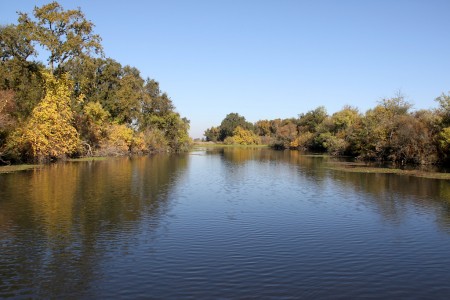Monday November 4, 2013
 It’s no secret that the vast majority of Central Valley streams have been extensively modified in the relatively brief period since the California Gold Rush of the mid 1800s. However, it can still be hard to come to terms with the new reality of these waterways: although charismatic and popular native species, such as salmon and steelhead, still call the waters home (often only seasonally), these habitats are now numerically dominated by nonnative species that were either deliberately or inadvertently introduced. As discussed in a recently published article in the journal River Research and Applications, these modified habitats represent novel ecosystems that still exhibit characteristics of natural species communities, with defined predator-prey interactions, competition among species, and a food web based on primary production. However, the altered composition of such systems poses a significant challenge to resource managers attempting to maintain and increase suitable habitat for native species.
It’s no secret that the vast majority of Central Valley streams have been extensively modified in the relatively brief period since the California Gold Rush of the mid 1800s. However, it can still be hard to come to terms with the new reality of these waterways: although charismatic and popular native species, such as salmon and steelhead, still call the waters home (often only seasonally), these habitats are now numerically dominated by nonnative species that were either deliberately or inadvertently introduced. As discussed in a recently published article in the journal River Research and Applications, these modified habitats represent novel ecosystems that still exhibit characteristics of natural species communities, with defined predator-prey interactions, competition among species, and a food web based on primary production. However, the altered composition of such systems poses a significant challenge to resource managers attempting to maintain and increase suitable habitat for native species.
Waterways in arid climates, such as in California or the Mediterranean region, are often among the most significantly altered in the world. Reasons for this include the strong motivation to capture and store seasonally available water resources for use during drier times of the year, and the relative ease of modifying such waterways for storage, diversion, or flood conveyance during times of little or no discharge. These altered habitats, including storage reservoirs and waterways with a flow regime that differs dramatically from historical patterns, are quickly exploited by non-native fish species that often come to dominate novel aquatic ecosystems. The disruptive effect of introduced species on native species assemblages is well documented, and redeye bass (Micropterus coosae) in the Cosumnes River (pictured above), or Sacramento pikeminnow (Ptychocheilus grandis) in the Eel River, are prime examples of alien species that have thrived in their respective novel ecosystems to the detriment of native fishes.
Realizing that most aquatic ecosystems in California, particularly temporary rivers, have been modified to a degree that renders true restoration unfeasible in most cases, the article’s author Dr. Peter Moyle refers to the concept of “reconciliation ecology” as the primary remaining and realistic management option. This concept recognizes that the altered state of many aquatic systems is not readily reversible, but that ecosystem change can be “guided” to maximize benefits to a defined group of desirable species. A prime example of reconciliation ecology in action is northern California’s Putah Creek. This historically intermittent stream once supported a diverse assemblage of native fish species, which were able to over-summer in remnant pools or seasonally migrate to the creek from the Sacramento River. Following dam construction, a large section of the creek fell dry for extended periods of time, but is now actively managed to favor native fish species that have once more have come to dominate many sections of the stream (Kiernan et al. 2012). Alien species can still be found in Putah Creek and are likely to stay, but the approach of managing the stream as a novel aquatic ecosystem is truly a success of reconciliation ecology. Though it bears little resemblance to its historic state, Putah Creek now supports human uses as well as alien plant and animal communities that exist alongside native assemblages without displacing them.
